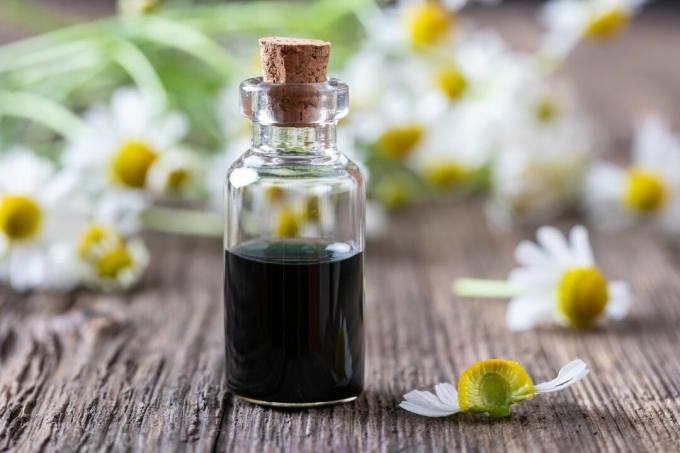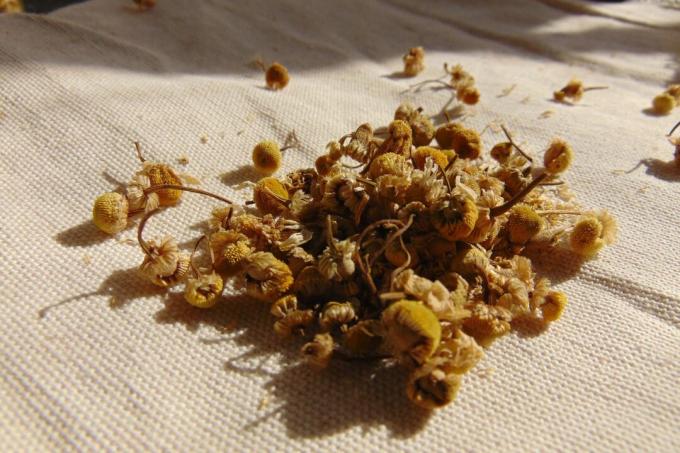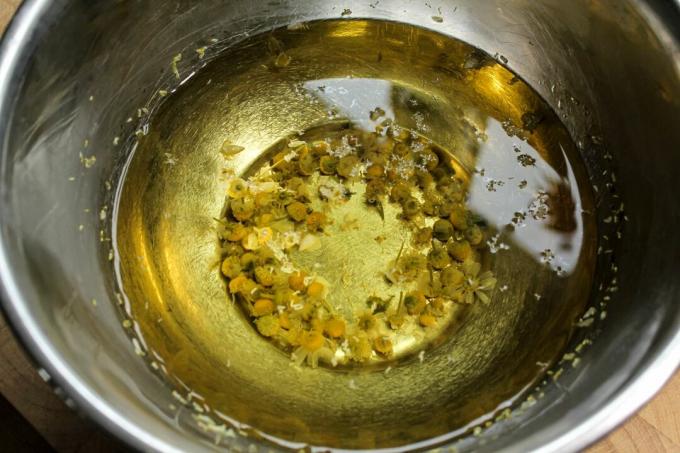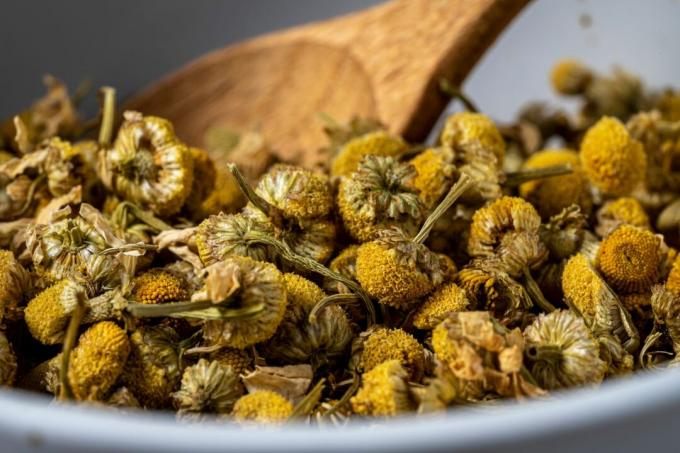The healing properties of chamomile have been known for centuries. But what makes chamomile so healthy, what active ingredients does it contain and what can chamomile be used for?

For centuries will chamomile (Matricaria) cultivated by us humans - and not only as a beautiful ornamental plant, but above all because of its effect as a medicinal plant. Healers have known about the positive effects of the plant for thousands of years. Teutons and Egyptians even worshiped the flower as a sacred plant of their sun deities. But even today, many people still swear by the beneficial power of chamomile. Chamomile is used for many ailments, for example against inflammation, abdominal pain or colds.
contents
- Effect of chamomile: what makes it so healthy?
- Can you eat chamomile?
-
Use of chamomile as a medicinal plant
- Chamomile tea: what does it help against?
- inhale chamomile
- Chamomile in ointments
- Chamomile as a bath additive
- chamomile oil
Effect of chamomile: what makes it so healthy?
The essential oil content is decisive for the effect of chamomile as a medicinal product. The proportion is highest in the flowers at 0.3 – 2.5%. This oil obtained from real chamomile is also called chamomile oil or blue chamomile oil. The main components of the essential oil are bisabolol and matricin, which have an anti-inflammatory effect. If chamomile oil is extracted using steam distillation, chamazulene is formed - this not only has an anti-inflammatory effect, but also gives the oil a deep blue color. The content of the active substances is highest in the real chamomile (Matricaria chamomilla), but also the Roman chamomile (Chamaemelum nobile) can be used as a medicinal plant. The species of dog chamomile (anthemis) are considered to be slightly poisonous and should not be used in medicine or cooking. The remaining Chamomile species Although they are not toxic, they do not contain any significant amounts of active ingredients and are therefore rarely used.

The ingredients of real chamomile have an antibacterial effect, prevent the effects of inflammatory substances and relax cramped muscles. Because of these properties, chamomile is used to treat numerous diseases from a cold to skin problems.
Is chamomile anti-inflammatory? Yes, real chamomile has an anti-inflammatory effect - both externally and internally. Applied as an ointment, chamomile unfolds its effect on the skin and helps against inflammation or neurodermatitis. But chamomile is also anti-inflammatory when taken as a tea, for example in the mouth and throat.

Can you eat chamomile?
Flowers, leaves and buds of chamomile are edible and can be used in the kitchen. Roots and stems are not usually used. Real chamomile is also edible for animals and unfolds its effect. Chamomile tea can also have a calming effect on dogs and help against gastrointestinal problems. Roman chamomile is also suitable for consumption. It smells and tastes subtly of apple. Some types of dog chamomile, on the other hand, are considered slightly toxic and should not be eaten. Pets such as dogs and cats should only consume small amounts of the plant, but an occasional nibble is harmless. Horses and rabbits can also tolerate small amounts of dog chamomile.
Is chamomile toxic to cats? The real chamomile is not poisonous for cats, but the dog chamomile species can cause slight symptoms of poisoning in large quantities.

Fortunately, chamomile is one of the medicinal plants that can also be used by laypeople without any problems, as it hardly shows any negative effects even if the preparation or dosage is “wrong”. Nevertheless, a few points should be heeded when using real chamomile as a remedy: Especially people with an allergy to daisy family (Asteraceae) should use chamomile as a home remedy foresee. These individuals can experience severe allergic reactions when contaminated with other daisy family species such as dog chamomile. There is a risk of confusion with this. more on the subject Varietal differences and risk of confusion in chamomile can be found in our special article. In addition, self-prepared chamomile solutions should not be used on or in the eye - they can be contaminated with germs and even cause eye infections.

Use of chamomile as a medicinal plant
The fact that chamomile has always been a must in every medicine cabinet is due in particular to the plant's ease of use, but also to its versatility. Real chamomile can also be used by laypeople as a homemade household remedy. Alternatively, Roman chamomile with similar ingredients can also be used. Chamomile is particularly suitable for children: chamomile tea, for example, can be used without hesitation for babies in an appropriate dose.
Chamomile tea: what does it help against?
Everyone probably knows chamomile tea from their childhood. Whether it’s a stomach ailment or the flu – the warm drink is said to help with a variety of illnesses. But is this an old wives tale or is chamomile tea actually healthy? In fact, the healing essential oils dissolve in the hot water and can provide relief from minor ailments. Homemade chamomile tea unfolds its calming effect, relieves cramps in gastrointestinal complaints and can also be beneficial for gastritis. Chamomile also helps against inflammation in the mouth and throat - used several times a day, a mouthwash with chamomile has an anti-inflammatory and pain-relieving effect. In southern Europe, the healthy chamomile tea is also widely used as a sleeping pill and sedative. Even with menstrual problems, the healing plant is said to have an antispasmodic effect.
Tip: Chamomile tea can also be used as a nourishing hair conditioner. It cares for the scalp and lightens the hair slightly.

As a home remedy, chamomile tea is not only healthy, but also extremely popular. No wonder - after all, it can be easily made from the medicinal plant. For a chamomile infusion, the flowers are used fresh or dried, the best time for which Harvest of chamomile is before fading when the flower is fully open. Two to three teaspoons of the dried chamomile flowers are poured into a cup of hot, but not boiling, water. After the tea has steeped for about ten minutes, you can strain the flowers and enjoy the healthy chamomile tea. A daily dose of real chamomile corresponds to 9 - 12 g of the dried flowers.

Benefits of chamomile tea at a glance:
- You can make chamomile tea yourself
- Helps with a variety of ailments
- Because of its calming effect, chamomile tea is a good choice to drink before bed
- The anti-inflammatory chamomile tea is effective for gastrointestinal disorders and menstrual cramps
- As a nourishing hair conditioner, chamomile tea has a lightening effect and soothes the scalp
- Chamomile tea is traditionally used for colds
inhale chamomile
Chamomile is probably best known for its beneficial effects on respiratory problems and colds. In fact, chamomile tea should not be used here - it is worth sweating if you have a bad cold. The active ingredients in chamomile reach the lungs through inhalation. Although inhaling a hot chamomile steam bath can be uncomfortable for some, it has a positive effect on the symptoms in the airways. To do this, hot water and two handfuls of chamomile blossoms are poured together in a pot: simply head for Cover the pot with a towel and hang over the pot for a few minutes and simmer for about 10 to 20 minutes exhale. This is often not particularly pleasant, but works wonders. The dry and irritated mucous membranes are moistened again by the steam, the essential oils of chamomile have a calming effect and alleviate the inflammation.

Chamomile in ointments
Chamomile can not only have a great effect as a tea - chamomile has also proven itself as a home remedy for the skin. A chamomile-based ointment can be applied, for example, to treat skin or mucous membrane inflammation or bacterial skin diseases. Chamomile helps with wound healing and has an antibacterial effect. Chamomile ointment can also bring about improvement when used in the case of infections in the oral cavity or on the gums.

Chamomile as a bath additive
Not only ointments are suitable for the external application of chamomile: a bath or sitz bath can also have a healing effect. Real chamomile has a healing effect on skin ailments such as neurodermatitis or light sunburn, whereby it has an anti-inflammatory and antibacterial effect and provides relief. In order to produce a suitable bath additive, 50 - 100 g of chamomile blossoms are infused with one liter of hot water. After ten minutes, the flowers are strained and the bath additive is added to the bath water. Sitz baths with chamomile also have an anti-inflammatory effect for diseases in the anal and genital areas, such as haemorrhoids or infections. Used in chamomile baths, the essential oils in the flowers soothe discomfort and speed healing.

chamomile oil
Chamomile oil is versatile. Chamomile oil is not only extracted from real chamomile, but also from Roman chamomile. You can add chamomile oil to the bath water along with a spoonful of honey for it to work its magic. You can also dip clean cloths in a bowl of water and a few drops of chamomile oil and make compresses out of them. This is then placed on parts of the body with neurodermatitis or muscle tension.
Do you want to grow real chamomile in your own garden? We have tips on the right one Care of chamomile.



